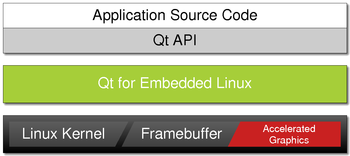Qt for Embedded Linux
Qt for Embedded Linux is a C++ framework for GUI and application development for embedded devices. It runs on a variety of processors, usually with Embedded Linux. Qt for Embedded Linux provides the standard Qt API for embedded devices with a lightweight window system.

Qt for Embedded Linux applications write directly to the framebuffer, eliminating the need for the X Window System and saving memory. The Linux framebuffer is enabled by default on all modern Linux distributions. For information on older versions, please refer to the Framebuffer HOWTO document. For development and debugging purposes, Qt for Embedded Linux provides a virtual framebuffer. It is also possible to run an application using the VNC protocol.
| Getting Started | Reference | Features |
|---|---|---|
| Development | Porting | Optimization |
Adding an Accelerated Graphics Driver to Qt for Embedded Linux | |
Describes how to reduce the size of Qt libraries by selecting only the features that are needed. | |
A guide to implementing atomic operations on new architectures. | |
How to install Qt for Embedded Linux. | |
Information about the licenses of fonts supplied with Qt for Embedded Linux. | |
Ways to improve performance on embedded platforms. | |
Classes that are specific to Qt for Embedded Linux | |
A guide to using Qt for Embedded Linux applications as VNC servers and clients. | |
© 2016 The Qt Company Ltd. Documentation contributions included herein are the copyrights of their respective owners. The documentation provided herein is licensed under the terms of the GNU Free Documentation License version 1.3 as published by the Free Software Foundation. Qt and respective logos are trademarks of The Qt Company Ltd. in Finland and/or other countries worldwide. All other trademarks are property of their respective owners.
